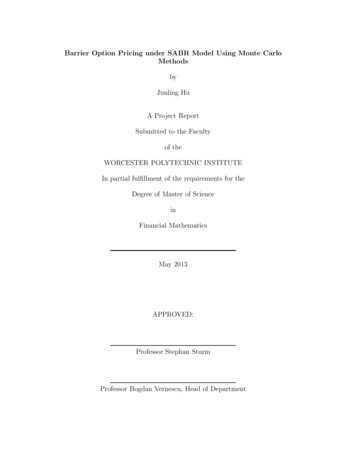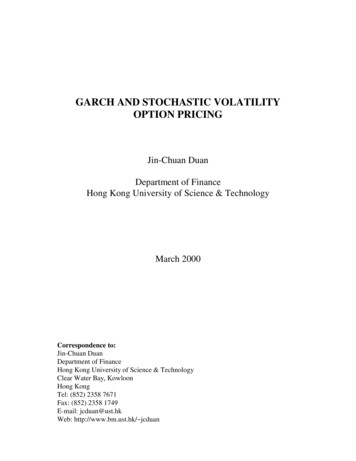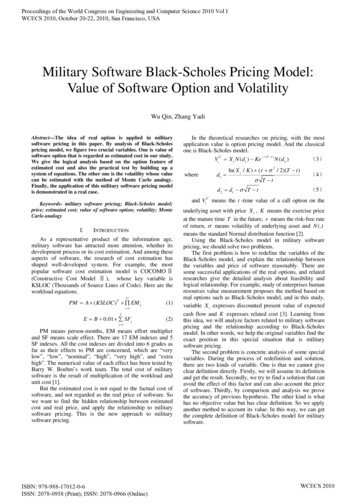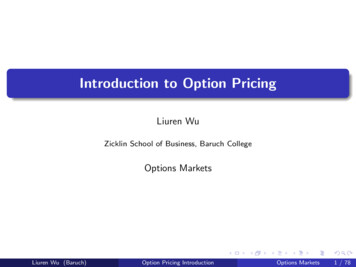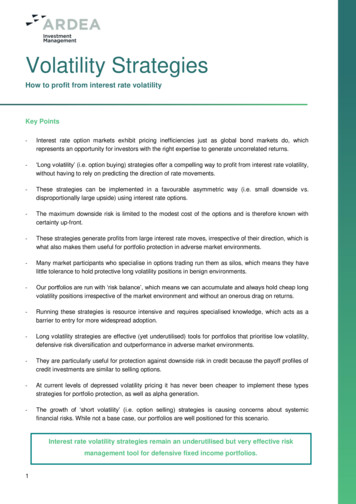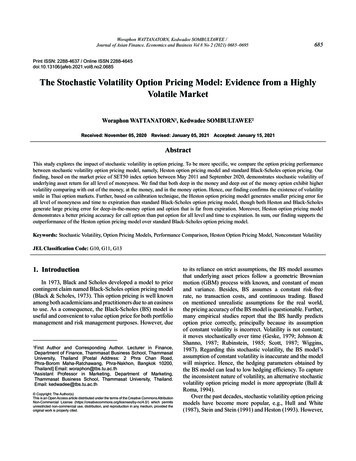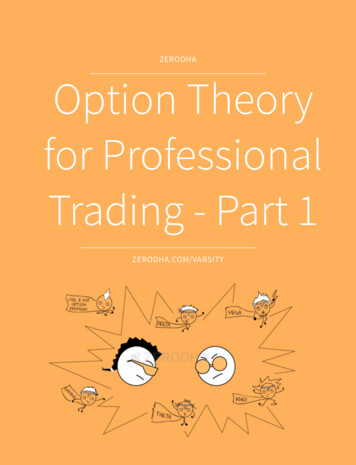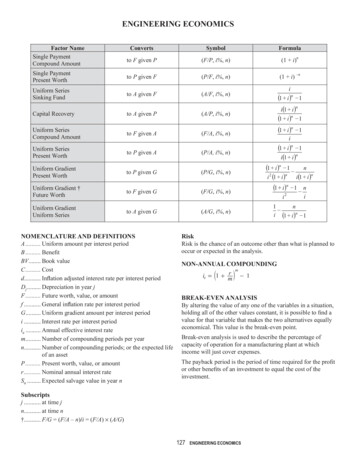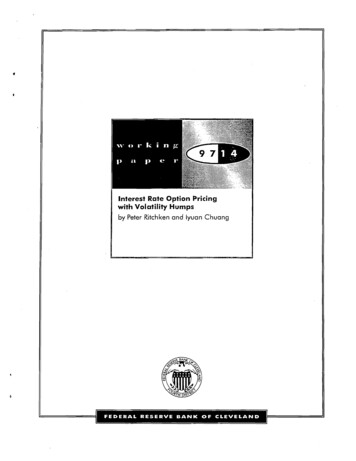
Transcription
Interest Rate Option Pricingwith Volatility Humpsby Peter Ritchken and lyuan Chuang
Working P a e 97r 14INTEREST RATE OPTION PRICING WITH VOLATILITY HUMPSby Peter Ritchken and Iyuan ChuangThe authors are on the faculty of the Weatherhead Schoolof Management, Case Western Reserve University. PeterRitchken gratefully acknowledges financial support fiomthe Federal Reserve Bank of Cleveland.Working papers of the Federal Reserve Bank of Clevelandare preliminary materials circulated to stimulate discussionand critical comment. The views stated herein are those ofthe authors and are not necessarily those of the FederalReserve Bank of Cleveland or of the Board of Governors ofthe Federal Reserve System.Federal Reserve Bank of Cleveland working papers aredistributed for the purpose of promoting discussion ofresearch in progress. These papers may not have beensubject to the formal editorial review accorded officialFederal Reserve Bank of Cleveland publications.Working papers are now available electronically throughthe Cleveland Fed's home page on the World Wide Web:http://www.clev.fib.org.December 1997
AbstractT h i s paper develops a simple model for pricing interest rate options. Analytical solutiorls are developed for European claims and extremely efficient algorithms exist for tile pricing of American opciolls.T h e interest rate claims are priced in the Heath-Jarrow-klorto i paradigm, a n d hence illcorporatefull information o n t h e term structure. T h e volatility. structure for forward rates is humped, a n dincludes as a special case the exponentially dampened volatility structure used in tile GeneralizedVasicek model. T h e structure of volatilities is captured without using time varying parameters. Asa result, the volatility structure is statiollav. It is not possible to have all ttle above properties holdin a Heath Jarrow Morton model with a single s t a t e variable. It is show11 t h a t t h e full dvliarnicsof t h e term structure can, however, be captured by a three s t a t e rCIarkovia11 system. As a result,simple path reconecting lattices cannot be constructed t o price American claims. Nonetheless, weprovide extremely efficient lattice based algorithms for pricing claims, which rely o n carrying smallmatrices of information a t each node. Empirical support for the models developed zre provided.
IntroductionTills article deals with the pricing of interest rate claims when interest rates are stochastic. Therrlethodology incorporates all current informationillthe yield curve.I:!particular, the lliodelsdeveloped are all cast iu the Heath, darrow arid Morton (1992) paradigm (hereafter HJhI). T h enlodels we propose have the following properties. First. sirrlple alialytical solutions are available formost Europearl claims. Second, the volatility of forward rates is humped, coiisistellt with elripiricalevidence. Third, the volatility structure of forward rates is a stationary function, in that it olllydepends or1 the maturity of the rate.' Fourth, the model includes, as a special case, the geueralizedVa icekmodels developed by .Jamsilidian (1989), HJXI (1992) arid Hull and White (1990), as wellas the continuous time Ho-Lee (1988) model. Fifth, the model permits the efficient computationof American interest rate claims. Finally, the single factor models we present readily generalize toniultifactor models.ncannot be understated. 111 particThe need for simple analytical solutions for u r o e aclaimsular, an important property of any derivatives model is that it not only prices discount bonds attheir observable values, but it also produces theoretical prices for an array of liquid derivatives thatclosely match their observable values. Typically, the calibration procedure is accomplished using thediscount function as well as the prices of liquid caps and swaption contracts. In the HJh.1 paradigm,all discount bonds will be automatically priced correctly. T h e parameters of the volatility structure,however, need to be determined so as to closely price a set of interest rate derivative contracts. Thisis usually zccomplished by minimizing the sum of squared residuals. With many parameters, andwith a highly non linear objective function, the optimization problem is no11 trivial, and multiplecalls to vaiuation routines for the individual contracts arise. If these individual routines are notefficient, then implied estimation of the parameters becomes difficult. As a result, an importantcriterion For successful implementation is the ease in which the model's parameters can be readilycalibrated. Since our simple model can easily be calibrated, it is likely to be more successful than amore complex model which might capture more precisely the volatility structure. but at the expenseof forgoing analytical solutions and hence incurring costly calibrations.The article proceeds as follows. In the next section we review the pricing rnechanisrn in the HJhIparadigm as well as the empirical evidence regarding the volatility hump. In section 3 we developspecific models for pricingEuropean.claims. We construct a two and three state-variable model,which includes as a special case the one state generalized Vasicek model. Analyticalsolution forEuropean options are provided. In section 4 efficient algorithms for pricing American claims are pro'In particular, there are no time vKying parameters in the model.
vided. The algorithms are similar in spirit to those of Li. Ritchken and Sankarasubramanian (1995).Their model involves one source of l ncertainty,yet req iiretwo state variables. Here, we also haveolie source of uncertaintv. However, up to three state variables are necessary to fully c a p t r r e t h edynamics of the term structure. We illustrate the collvergeIlce behavior of our algorith!ris.Sec-tiori 5 illustrates how the analysis geiieralizes to two sources of uricertainty, section 6 provides someempirical support for tile huniped volatility nlodel arid section i sumlnarizes our findirigs.2Pricing Mechanisms for DerivativesLet f ( z ,T ) be the forward rate a t date z for the instantaneous rate beginning a t date T . Forwardrates are assumed to follow a diffusion process of the formdf ( r ,T ) p ( z ,T ) d t f a (z, T ) d u j ( z )(1)with the forward rate function f (0,-) initialized to its currently observable value. Here p ( z . T ) ando ! ( z , T ) are the drift and volatility parmeters which could depend on the level of the forward rateitself, and d w ( z ) is the standard Wiener increment. H J k l (1992) have shown that to avoid risklessarbitrage the drift term must be linked to t h e volatility term by:: u f ( z , v ) d v and A( ) is the market price of interest rate risk, which is indepenwhere u p ( z , T ) Jdent of the maturity date I. Substituting equation ( 2 ) into (I) a n d integrating leads toNow consider the pricing of a n European claim that promises t h e holder a payout of g ( t ) a t d a t e t .Here g ( t ) is a cash Bow fully determined by the entire term structure a t that date. The arbitragefree price of this claim a t date 0 is given by:where P(0, t ) is the price a t date 0 of a bond that pays 1 a t d a t e T . This expectation is computedunder the forward risk adjrrsted process, which loosly speaking, is obtained by pretending X(v) - o p ( v , t ) in equation ( 2 ) . With this substitution, equation ( 3 ) can b e written as:
whereFor pricing Europeari claims it is usually easier to work ullcler the forward risk adjusted process.Irl contrast, for pricing America11 clainls, olle usually proceeds by valuing under the risk ner trnlizcdprocess. In particular, as a n alternative to equatiou (4), we have:T h e risk neutralized process can be viewed as a process where the market price of risk at datecistaken to be 0. Under this process, equation ( 3 ) reduces towhereFrom a valuation perspective, the HJbI paradigm provides a Framework where, given an initialterm structure, the pricing mechanisin can proceed once the volatility structure of forward rates isspecified. T h e simpliest volatility structure in thegiven asHJM paradigmis t h e constant volatility structureT ) u. This structure assumes all rates respond to a shock in the same way. Cursoryempirical evidence suggests that volatilities of forward rates depend on their maturities.HJM (1993)and Jamshidian (1989) consider a n exponentially dampened structureThis structure, referred to as the Generalized Vasicek o r GV structure, implies t h a t distant forwardrates are much less volatile than near forward rates. If volatilities have this structure, then it can beshown that the entire dynamics of the term structure can be characterized by a single s t a t e variable,which could be the instantaneous spot rate? r ( t ) f ( t . t ) , and that bond prices can be representedwhere
Ritchken and Sankarasubramanian (1995) show that if volatilities are not of this form the11 there isno single state variable HJhi representation for the dynamics of the term structure.There appears to be very little empirical support for an exponentially dampened forward ratevolatility structure. Several researchers report a hump in the volatility structure that peaks at aroulidthe two year maturity. Heath, Jarrow Morton and Spindel(lW2) provide cursory evidence of such ahump. Amin and Morton (1994) use Eurodollar futures and options and obtain negative estimates ofKover the short end of the curve. Since negative estimates over the entire maturity spectruln are notplausible, they argue that there is a hump in the structure. Goncalves and Issler (1996) estimate theterm structure of volatility using a simple GV model. Their historical analysis of forward rates alsoreveals a hump.' In addition to not providing for a volatility hump, GV models have the undesirableproperty that volatilities of yields are independent of their levels. As a result, interest rates can go'negative. These problems have lead researchers to consider richer classes of volatility structures inwhich volatilities are linked directly or indirectly to the level of the term structure.While the HJM paradio-permits the volatility structure to be quite general, unless constraintsare imposed on the family of volatilities, a finite state representation of the term structure is notpermissible. Ritchken and Sankarasubramanian (1995) characterize the set of restrictions on volatilities t h a t permit a two state variable representation. In particular they show that if the volatilityhas the formg i ( t , T ) gt-(t)k(t,T )where a,(t) is a function that depends on all information up to date t, and k ( t , T ) is a deterministicfunction satisbing the following serni-goup property:then, conditional on knowing the initial term structure, knowledge of any two points on the termstructure a t date t is sufficient to characterize the full yield curve a t that date. T h e class of volatilitystructures in this family is quite large.However, no analytical solutions have been derived forEuropean claims. As a result, calibration issues remain, which inhibit the easy implenientation ofthese models.' N o t dl studies indicate the existence of a hump. For example, Bl'ks and Ritchken (1995) use term structure dataalone and find that relative to the volatility at the short end, forward rate volatilities appear to decline with maturity.-
111the next section we propose generalizing the GV model in such a way ttrat the volatilitvstructure is humped.By maintaining deterministic volatility structures, aiialytical sohttio istoirlterest rate claims is plausible. While deterministic structures do trave li nitatiorls,by iircorporatirigthe volatility hump, and by yieldirig a pricing mechanism that permits allalytical solutioris to bederived for European options, efficient calibration and yields efficient pricing of American claims canbe accolnplished.3Option Pricing with a Volatility HumpAssume the volatility structure is given by:This volatility function reduces to theGV structurewhen a1 bo 0. Bhar and Chiarella (1995)have considered similar structures for volatilities. Indeed, they show t h a t a finite state hIarkovrepresentation is permissible for the term structure if the coefficient of the exponentially dampenedterm is a finite degree polynomial in the maturity T - z. Figure 1 shows a typical curve,the peak occurs around the two year point.[Figure 1 Here]For 0 5 z t , the volatility structure can be expressed as:a,( ,T ) d o ( t . T ) d l ( t , ) e - ( ' - d)2 ( t . T ) [ t - ] e - ( ' - )whereSubstituting equation (10) into equation ( 5 ) yields:whered (u)u5illwhich
tV2(t) I'( t - lJ)r-K(t-"!rill1 ( v )a n d the exact expression for h l ( t , T ) is provided ill the appendix.P r o p o s i t i o n 1 If the volatility stnrctr reis given by eqt ation(9), and the dynamics of the fanlrardrates nre given by eqiration(l), then, rtnder the FRA process, bond prices at dnte t art: linked to pricesat dnte 0 through three state variables, CVo(o(t),CVl(t) and I.F2(t) as:whereandT h e dynamics of the state variables, t V l ( t ) , and W 2 ( t ) are:Proof: See Appendix.When bo 0, D o ( t , T ) 0, and the number of state variables reduces to 2. Further, whena1 bo 0, then, the number of state variables reduces to 1, the GV volatility structure isrecovered and the bond pricing equztion reduces to equation ( 8 ) .Under the FRA process, viewed from date 0, the bond price, P ( t , T ) ,has a lognormal distribution.I n particular, R ( t , T ) is normal with mean 0 and variance r 2 ( t , T ) ,where:
andtVe now can compute analytical solutions for a large family of European interest rate claims. Proposition 2 provides the solution to an European option on a discount bond.P r o p o s i t i o n 2 If the volatility structure i s given by e p a t i o n(g), then the price of a contract thatprovides the holder with the right to buy nt date t, a bond that matrrres at date T , for X is givenby:C ( 0 ) P(O, T ) N ( d l ) - X P ( 0 , t ) N ( d 2 )(19)whereand 7 * ( t ,T ) is given by equation (18).Proof: See Appendix.Notice that when a1 bo 0 , the formula reduces to the4GV option model of Jamshidian (1989).Pricing American Options Under Humped VolatilitiesT h e advantage of a simple deterministic volatility structure as it, equation (9), is that it permits thedevelopment of analytical solutions for many European claims including caps, floors, and swaptions.The resulting expressions have the same form as their simpleGV counterparts, except the volatilityexpression ( 7 ( t , T ) ) takes on a more complex form. Analytical solutions for suchclaims are usefulsince they reduce the complexity of the calibration process. Once the parameters are estimated,
then lattice based algorithms can be used to price a variety of American clainissome interestrate exotics. I n this section we describe such algorithms.The valuation procedure takes place using the risk neutralized measure. Under this measure theterm structfire at date t is given by:f ( t .T ) f ( 0 . T ) hz(t. T ) T)dUJ(V) t u p ( l l .and the bond pricing equation is:whereA t ) P(0.T)e-fi2(t,r)P(O,t)Assume the time interval [0,t ] is partitioned into n equal subintervals of width h. A simple binomiallattice is used to approximate the standard Wiener process. Let LV& approximate the process attime ih for i 0 , 1 , 2 , .,n, with W&,and LV& 0. Given W&, the next permissible values are W&- A,which both occur with probability 0.5. fiFor pricing purposes, the term structure cacbe recovered a t each node of the lattice if the exact values of the three state varibales are given.Let (WP, Lr.20) be the values of the two state variables a t a particular node, where the first statevariable has value W:. T h e number of different values for the state variables WP and W; a t thisnode equals the number of different paths that can be traversed from the originating node to thispoin't. Rather than keep track of all these values, we follow the basic idea of Li, Ritchken andSahrasubramanian (1996) and only keep track of the maximum and minimum values that each ofthe two state variables can attain at each node. The range between the maximum and minimumvalues is then partitioned into k l and k2 pieces respectively. Option prices are then kept track of a tthe resulting kl x k2 points. Thus a t each node in the lattice, a matrix of option values needs to beestablished.Let C ( i ,j) be the (i,j)'h entry for a price that is to be computed a t the node LV; and assumeWp y and W; z . Assume the date is mh say, for some integer ms t a t e variables, their successor values a t date ( m5(n- 1); Given these.two l ) h can be computed using approximations -toequations (16) and (17). In particular, the two successor nodes are (a f i )and (u - &)both of
which occur with probability 0.5. The values of the two state variables, obtained using eq latioiis(16)a i d (17). a t these two nodes, are (!I- ( 1 1 )fi,z (!I - r i z ) l t ) and (!I - (K!/lI)- fi.: (!I - ) l r )respectively. Option prices a t the succcessor nodes, for these particular s t a t e variables.II HVi o tbe available. However, option prices at "surrounding" states will Le available. aiid irlterpoiatiotlprocedrires can be used to establish an option price. T h e average of the optioil prices cou putedinboth the up state and down state can then be computed, and the resultirlg value discou itedby thecurrent one period bond price, provides the value of the option unexercised a t the current location.Tile maximum of this value and the exercised value of the claim provides tlie iumericalvalue forC ( i ,3 ) .When computing option prices using backward recursion, variow interpolatior techiiiques canbe used to establish the values of the claim in both succ&sor states. Li, Ritchkei and Sankarasubramanian (1995),show t h a t relatively coarse partitions of the range of the s t a t e variable a t each node,combined with simple linear interpolation methods produce satisfactory results for their problem.3\Ve first report on the performance of a n algorithm for the volatility structure ill equation (9)with a1 0. In this case there are only two state variables. Since analytical solutiolis are availablefor European options o n bonds, we use these contracts to illustrate the convergence behavior for thecontract as the number of time partitions, n, and as the number of space partitions, kl, increase.Figure 2 reports the results for the one year at-the-money option, when a simple linear interpolationmethod is used.[Figure 2 Here]Notice: that for all time partitions, as kl is increased the convergence rate improves. Notice too,that reasonably accurate results for option prices are. obtained for 5 0 time partitioris and about 5space partitions.4Table 1 compares the convergence rate of prices for various space partitions using a linear interpolation scheme, to the case where only 3 points are used to approximate the s t a t e variable a teach node. but a quadratic approximation is invoked. As can be seen, the quadratic approximationworks very effectively, producing accurate results even for a small number of time partitions.[Table 1 Here]"orexample, they show that partitions of size 10 to 20 produce prices of options on bonds that are praqicallyindistinguishable.4Sirnilar results hold over the full range of pararnetrs for the volatility structure.
Figure 3 shows the convergence of option prices to the analytical solutiori for the general volatilitystructure with a1 # 0. In Figure 3 the partition sizes ( k l and ks) for the two state variablesrl.*l(t)and LV2(t) are taken to be equal.[Figure 3 Here]Table 2 shows the effects of using a quadratic approximation scheme rather than linear interpolatiori.Using just three points for each state variable a t each node appears to suffice. These results arequite robust to the parameter values for the volatility structure.[Table 2 Here]5Multifactor ModelsT h e above analysis readily generalizes to multifactor models. In this section we consider a specifictwo factor model which has the property that the factors are correlated. In particular assuming thefollowing dynamics for forward rates:df ( t , T ) p ( t , T ) d t u f l( t , T ) d w ( t ) 0 f 2 ( t , T ) d w 2 ( t )whereuf l ( t , T ) aoe-R(T-t)u f 2 ( t , T ) boE [ d w l d w z ] pdtThis model difiers from simple two factor GV model, in that t h e two factors are correlated. Transforming this model, we obtain:where d 1 and d 2 are standard independent Wiener increments with E [ d l d 2 ] 0. Moreover,under the forward risk adjusted process,Now, from equation ( 2 3 )
whered(t,T) aor-a(x-t)dl:Further, the bond price can be computed aswhereThis two factor model is characterized by three state variables. Straightforward lattice proceduresas outlined above can then be used to proxy the dynamics of the term structure. Analytical solutionfor European options on discount bonds are permissible. Similar to Proposition 2, we can obtainthe price of a contract that provides the holder with the right to buy a t date t, a bond that maturesa t date T , for X as:C ( O ) P ( o , T ) N ( I )X P ( O ,t ) ( d )(24)where6Empirical TestsIn this section we provide some preliminary empirical tests on the GGV model: Our goal toestablish if there is support for the one factor GGV model and to establish whether the model canreduce out of sample biases that exist in applying the simple GV model.
We obtained a set of daily caplet data, and zero curves from B e a n Stern. Tile data cotlsistsof prices of at-the-money capiets with maturities ranging from 1 year to 9 years in increments of 1year. Each caplet is on a 3 month LIBOR rate. The prices are reported in Black volatility form.To translate these numbers into prices we require the discount rates for the appropriate maturities.T h e discount function for each day, computed using the par swap rate curve was also s ipplied. 13weeks of data were provided.In our analysis, we assume all the parameters remain constant over a week. Then we use all9 x 5 45 option prices, to infer out the set of estimates that minimize, the sum of squared error.'We repeat this analysis, separately for each of the 10 successive weeks. Table 3 reports the estimatesof the parameters for each of the 10 optimizations for the GV and the GGV models.[Table 3 Here]For the GV model, the volatility and mean reversion estimates are fairly stable over the 10 weeks.For the GGV model, in addition to the estimates of the volatility parameters, we also report theforward rate maturity with the maximum volatility. This maturity is consistently close to 1.3 years,and the magnitude of the volatility there is surprisingly stable a t a value near 0.015. In all 10 runsof the GGV model, the null hypothesis that the parameter values a1 bo 0 is rejected a t the 5%level of significance. That is, the inclusion of the volatility hump, beyond the usual GV exponentiallydampened structure, adds significantly to the model.Table 4 summarizes the in-sample residuals for the GV and GGV models. In each of the 10weekly estimations for both models, 5 residuals are available.for each maturity. This gives a tota!of 50 residuals. For each maturity, the number of positive and negative residuals are indicated, as.well as their average and standard deviation.[Table 4 Here]The table immediately reveal's the large biases in the'GV model. All the residuals in the firstyear are negative, while all the residuals in years 2- 4 are positive. The large bias continues over allmaturities. Figure 4a illustrates the biases for a typical week. Here, the 9 residuals for each of the5 days in the week are plotted. As can be seen, the simple exponentially dampened structure forvolatilities is not flexible enough to permit pricing to proceed without introducing a large maturitybias.5We minimized the sum of squared error of the pricing w i d d , in dollars, and in implied volatility units. In bothcases,theSetof iesults were h a s t identical. As a result. we use the first objective, but report all our residuals inBlack volatility form.
[Figure 4 Here]Table 4 also reports the results for the GGV model. Relative to the G V model, a significantamount of the bias is removed. Figure 46 illustrates the pattern oE residuals for all 5 days of a typicalweek.T h e in sample analysis does indicate that a GV model is not capable of fitting a volatilitystructure that has a hump. Table 4 presents a similar analysis of residuals, this time conductedOHout-of-sample data. The estimates of the volatility parameters, derived using the data in a givenweek, are then used to estimate the option prices for each day of the next week. That is, the volatilityparameters are only updated at the end of a week, using full information on the entire week. Themodel is then not recalibrated until the end of the next week. As a result, for the week, we obtain9 x 5 45 out of sample residuals for each maturity. Table 5 reports the number of positive andnegative residuals as well as their means and variances for each maturity caplet.[Table 5 Here]T h e results are consistent with the results from the in-sample-residuals. In particular, muchof the bias in the GV model is eliminated by the GGV model. The last row of this table reportsthe number of times (out of 45) that the absolute value of each GGV residual is smaller than theahsolute value of the GV residual. The superior performance of the GGV model, especialiy over thethe first 5 maturities is evident. Figure 6 provides a plot of the difference in the absolute values ofthe residuals. The figure confirms the fact that the GGV dominates the GV model, in that the outof sample residuals produced by GGV are generally much smaller than GV.[Figure 6 Here]T h e above results provide significant evidence that the GGV can explain prices of caplets beyondwhat is possible with a GV model. T h e final table attempts to establish whether the forecasted GGVprices of caplets are within typical bid ask spreads and whether the forecasts deteriorate over time.For each out-of-sample day, we report the distribution of the 9 x 9 81 out of sample residuals. Forexample, consider the one year maturity caplet. Of the 81 forcasts made for the Monday prices, 68were within 0.25 vols o f the actual price, 11 was within 0.5 vols and 2 were larger. The performance ofthe forecasts did deteriorate somewhat over the next 4 days. However, even if one did not recalibratethe model for 1 week, 71 out of the 81 residuals were within 0.5 vols of the actual prices. S i r i eatypical bid ask spread of a caplet is often between 0.25 and 0.5 vols, residuals of this magnitude arerespectable. The results hold true when broken down by caplet maturity.
[Table 6 Here]Our preli!nir ary empirical results indicate that a significant portion of the bias ill the G V modelcan be explained by a more flexible handlilig of the volatility structure. Certainly, the prelinlilla? results do indicate that the naturity structure of at-the-molley caplets cau be reasorlably wellapproximated by the GGV nlodel.7ConclusionThis paper develops a simple model for pricing interest rate options. Analytical solutioris are available for European claims and extremely efficient algorithms exist for the pricing of American options.T h e interest rate claims are priced in the Heath-.Jarrow-Morton paradigm, and hence incorporatefull information on the term structure. The volatility structure for forward rates is hurnped, audincludes as a special case the Generalized Vasicek model. The structure of volatilities is capturedwithout using time varying parameters. As a result, the volatility structure is stationary. It isnot possible to have a volatility structure with the above properties and a t the same'time capturethe term structure dynamics by a single state variable. It is shown that the full dynamics of theterm structure can, however, be captured by a three state Markovian system. As a result, simplepath reconecting lattices cannot be constructed to price American claims. Nonetheless, we provideextremely efficient lattice based algorithms for pricing claims, which rely on carrying small matricesof information at each node.Our preliminary empirical analysis provided strong support for the single factor GGV model infavor over the GV model. Moreover, the GGV model produces somewhat stable parameter estimates,and was capable of producing out of sample prices that were consistently within reasonable bid s kspreads. The results indicate that a more thorough empirical study is waranted, where a larger dat?set is used covering a wider family of contracts.It also remains for future work to extend these models to handle a larger class of iorward ratevolatility structures. As long as the volatility structure is a sum of weighted exponential functionsmultiplied by maturity dependent polynomials, then a finite state variable representation is possible.When the volatility structure of forward rates belongs to the Ritchken-Sankarasubramanianclass,then the analysis becones more difficult. Extensions of our lattice procedure to handle humpedvolatility structures within the extended Ritchken Sankarasubramanian class will be of substaitialinterest.
AppendixProof of Proposition IBy definition of P ( t , T ) and equation ( l l ) ,we can write: A ( t , ) e ' ( " )whereandH ( t ,T) L hl ( t ,r ) d r computing this integral yields
Proof of Proposition 2By definition of call option which expires at date t:The expected payoff under the FRA measure at date t is given by:whereand 7 2 ( t ,T ) V a r ( R ( t , T ) ) .From equation ( 4 ) , we can write:Note that H 1 ( : , T ) - / ' ( t , T ) / 2 .
ReferencesArniri, I ., and A. Morton (1994),"InipIied Volatility Functions in Arbitrage-Free Term StructurekIodels," .lortmnl of Finnncinl Economics, 35, 141-180.Bhar, R., and C. Chiarella (1995),"
the volatility hump, and by yieldirig a pricing mechanism that permits allalytical solutioris to be derived for European options, efficient calibration and yields efficient pricing of American claims can be accolnplished. 3 Option Pricing with a Volatility Hump Assume the volatility structure is given by:
